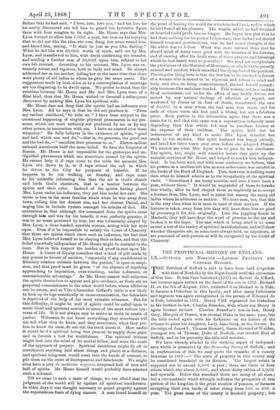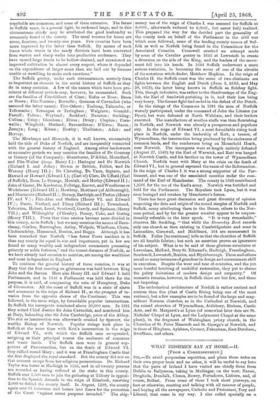THE PROVINCIAL HISTORY OF ENGLAND.
LX.—SUFFOLK AND NORFOLK :- LANDED PROPERTY AND GENERAL HISTORY.
THE Earldom of Suffolk is said to have been held (together with that of Norfolk) by the Bigot family until the extinction of that line. It was then bestowed (1337) on Robert de Ufford, but became again extinct on the death of his son in 1382. Richard II. on the 6th of August, 1385, conferred it on Michael de la Pole. It became a Dukedom in this family, and after many forfeitures and regrants was again extinguished in the person of Edmund de la Pole, beheaded in 1513. Henry VIII. regranted the Dukedom to his brother-in-law, Charles Brandon, with whose son Henry it again became extinct. Charles Brandon's son-in-law, Henry Grey, Marquis of Dorset, was created Duke in the same year, but the title ended again with his forfeiture on the failure of the scheme to place his daughter, Lady Jane Grey, on the throne. In the reign of James I., Thomas Howard, Baron Howard of Walden, youngest son of Thomas, Duke of Norfolk, was created Earl of Suffolk, and in his posterity the title still remains.
We have already alluded to the striking aspect of independ- ence which is presented by the Domesday Survey of Suffolk ; and in confirmation of this, we may quote the remarks of a county historian in 1813 :—" The state of property in this county may be considered beneficial in its division. The largest estate is supposed not to exceed 8,5001. a year ; there are three or four others which rise above 5,000/., and about thirty others of 3,0001. and upwards. Below this standard there are many of all sizes ; but a circumstance which strongly indicates the prosperity of this portion of the kingdom is the great number of yeomen, or farmers occupying their own lands, of value rising from 100/. to 400/. a year. The great mass of the county is freehold property ; but
copyholds are numerous, and some of them extensive. The farms in Suffolk must, in a general light, be reckoned large, and to this circumstance chiefly may be attributed the good husbandry so commonly found in the county. The usual tenures for leases are seven, fourteen, and twenty-one years. Few counties have been more improved by the latter than Suffolk. By means of such leases whole tracts in the sandy districts have been converted from warren and sheep walks into productive enclosures. They have caused large tracts to be hollow-drained, and occasioned an improved cultivation in almost every respect, where it depended on the expenditure of larger sums than are laid out by farmers unable or unwilling to make such exertions."
The Suffolk gentry, under such circumstances, scarcely form so important an element in the social history of Suffolk as they do in many counties. A few of the names which have been pro- minent at different periods may, however, be enumerated. Such are the families of Fitz-Gilbert of Clare ; Rufus or Rous ; Breos or Brews ; Fitz-Eustace ; Berwelle ; Gernons of Cavendish (who assumed the latter name) ; Fitz-Osbert ; Toelmag, Talmache, or Tollemache ; Termegan or Teringham ; Walgrave ; Gosnold ; Fastolf ; Felton ; Weyland ; Seckford ; Naunton ; Suckling ; Cullum ; Crisp ; Glemham ; Elwes ; Drury ; Clopton ; Corn- wallis ; Wingfield ; Harland ; Barnardiston ; D'Ewes ; Bacon ; rierroyn ; Long ; Kitson ; Rowley ; Thellusson ; Adair ; and Hervey.
The Mowbrays and Howards, it is well known, successively held the title of Duke of Norfolk, and are inseparably connected with the general history of England. Among other landowners at successive periods we may mention the families of De Gournay or Gurney (of the Conquest) ; Sharnburne, D'Albini, Mountford,
and Fitz-Walter (temp. Henry I.) ; Haringey and De Norwich
(Richard I. and John) ; Breton or Britton, Folliot, and De Waveny (Henry III.) ; De Clavering, De Vaux, Segrave, and Haward or Howard (Edward I.); (Earl of) Clare, De Ufford (Earl of Suffolk), Roos, Le Strange, Montalt, and Morley (Edward II.) ; John of Gaunt, De Kerdeston, Felbrigg, Knevet, and Woodhouse or Wodehouse (Edward III.); Mowbray, Mortimer (of Aldborough), and Montacute (Richard II.) ; Berney, Bardolph., and Pesten (Henry IV. and V.) ; Fitz-Alan and Shelton (Henry VI. and Edward IV.) ; Deere, Narford, and Tilney (Richard III.) ; Townshend, Yelverton, Hobart, Lovel, Southwell, Gawdy, and Spelman (Henry VII.) ; and Willoughby (d'Eresby), Denny, Coke, and Goring (Henry VIII.). From that time estates become more divided in this county, as in Suffolk ; but we may mention the names of Beau- champ, Gurdon, Burroughes, Astley, Walpole, Windham, Chute, Cholmondeley, Hammond, Buxton, and Bagge. Although it has been remarked that Norfolk " has fewer Peers resident in it than any county its equal in size and importance, yet in few are found so many wealthy and independent commoners possessing princely or noble fortunes," and the tenant-farmers of Norfolk, as we have already had occasion to mention, are among the wealthiest and most independent in England.
To continue the general history of these counties, it was at Bury that the first meeting on grievances was held between King John and the Barons. Here also Henry III. and Edward I. held Parliaments, and in 1446 a Parliament was held there for the purpose, it is said, of compassing the ruin of Humphrey, Duke of Gloucester. All the coast of Suffolk was in a state of alarm and armament in the reign of Richard IL, at the prospect of in- vasion from the opposite shores of the Continent. This was followed, in the same reign, by formidable popular insurrections.
In Suffolk the insurgents numbered above 50,000 men. In 1381 they seized Chief Justice Sir John Cavendish, and murdered him at Bury, beheading also Sir John Cambridge, prior of the Abbey. The riot or insurrection was afterwards crushed by Spencer, the warlike Bishop of Norwich. Popular risings took place in Suffolk at the same time with Kett's insurrection in the reign of Edward VI., with which the Suffolk men co-operated, assigning as their principal reason the enclosure of commons and waste lands. The Suffolk men were in general sup- porters of Protestantism, but on the death of Edward VI. they rallied round Mary ; and it was at Framlingham Castle that she first displayed the royal standard. But the county did not on that account escape from her religious persecutions. Dr. Richard Taylor was burnt at Hadleigh in 1555, and in all twenty persons are recorded as having suffered at the stake in this county. Suffolk sent 2,500 men to join the gathering at Tilbury in opposi- tion to the Spanish Armada in the reign of Elizabeth, reserving 2,000 to defend the county itself. In August, 1599, the county again sent 81 horsemen and horses into Essex for the protection of the Court "against secret purposes intended." The ship-
money tax of the reign of Charles I. was assessed for Suffolk at
8,0001., afterwards reduced to 6,000/., but never fully realized. This prepared the way for the decided part the generality of the county took on behalf of the Parliament in the civil war which soon followed, some of the leading county names of Suf- folk as well as Norfolk being found in the Committees for the Associated Counties. Cromwell crushed an attempt made by some of the Cavalier gentry in 1643 at Lowestoft to create a diversion on the side of the King, and the leaders of the move- ment fell into his bands. In 1644 Suffolk underwent a more serious visitation, in becoming the scene of one of the circuits
of the notorious witch-finder, Matthew Hopkins. In the reign of Charles II. the Suffolk coast was the scene of two obstinate sea fights between the English and Dutch (June 3, 1665, and May
28, 1672), the latter being known in Suffolk as Solebay fight. This, though indecisive, was rather to the disadvantage of the Eng- lish, the Earl of Sandwich perishing in it, and their loss being very heavy. The former fight had ended in the defeat of the Dutch. In the risings of the Commons in 1381 the men of Norfolk warmly participated, under the command of John the Litester (or Dyer), but were defeated at North Walaham, and their leaders executed. The manufacture of woollen stuffs was then flourishing in Norfolk, and Norwich was already a prosperous and populous, city. In the reign of Edward VI. a most formidable rising took place in Norfolk, under the leadership of Kett, a tanner, of Wymondham, the insurrection being produced by the enclosures of common lands, and the rendezvous being on Mousehold Heath, near Norwich. The insurgents were at length entirely defeated (August 27, 1549) by the Earl of Warwick, and Kett was hanged at Norwich Castle, and his brother on the tower of Wymondham Church. Norfolk went with Mary at the crisis on the death of Edward VI., but in general espoused the cause of the Reformation:. In the reign of Charles I. it was a strong supporter of the Par- liament, and was one of the associated counties under the com- mand of the Earl of Manchester. The county in 1643 contributed 1,2501. for the use of the Earl's army. Norwich was fortified and held for the Parliament. The Royalists took Lynn, but it was soon besieged and retaken by Manchester's forces.
There has been great discussion and great diversity of opinion respecting the date and origin of the round steeples of Norfolk and Suffolk, many attributing them to the Danes, others to the Nor- man period, and by far the greater number appear to be unques- tionably referable to the later epoch. "It is very remarkable," observes Mr. Suckling, " that while the Domesday Book records only one church as then existing in Cambridgeshire and none fir Lancashire, Cornwall, and Middlesex, 364 are enumerated in Suffolk. Fuller [he continues] tells us that the churches of Suffolk are all humble fabrics ; but such an assertion proves an ignorance of his subject. What is to be said of those glorious structures at Lavenham, Melford, Bury St. Edmund's, Hadleigh, Framlingham, Southwell, Lowestoft,Beccles, and Blythborough. These and others are all so many instances of grandeur in design and consummate skill in execution. Despite the wear and tear of centuries, and the yet more hurtful botching of unskilful restoration, they put to shame the paltry imitations of modern design and carpentry." Of monastic remains, however, in Suffolk there are but few, and these not imposing.
The ecclesiastical architecture of Norfolk is rather ancient and curious than flue (that of Castle Rising being one of the most curious), but a few examples are to be found of the large and mag- nificent Norman churches, as in the Cathedral at Norwich, and the ruined churches of Wymondham, Attlebury, Binham, Castle Acre, and St. Margaret's at Lynn (of somewhat later date are St. Nicholas' Chapel at Lynn, and the Ladymount Chapel at the same place), in the fragment of Walsingham priory church, in the Churches of St. Peter Mancroft and St. George's at Norwich, and in those of Hingham, Aylsham, Cromer, Fakenham, East Dereham, Swaffham, and others.



































 Previous page
Previous page